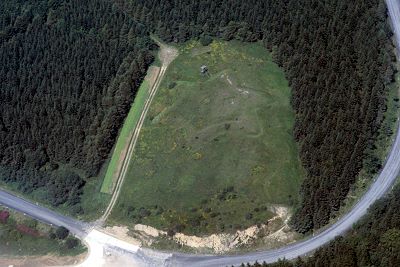Last Saturday the usual gang of reprobates played a Rossbach scenario. Historically a rapid, crushing, fortune-reversing, Prussian victory and pursuit that became legendary, in our game they won by the skin of their teeth, barely holding on with heavy casualties.
 |
| The Franco-Imperials debouching onto the plain... |
 | |||||||
| ...and advancing to outflank the Prussian deployment. Rossbach and Luenstadt are in the foreground. |
 |
| The Prussians confidently waiting for their enemies. |
| The Prussian center. |
 |
| Heavy fighting for the town objectives decided the game. |
 |
| The Prussian right, the only part of the army that held on to its positions. (More Rossbach game photos in Dinos Antoniadis' album) |
A few months ago we had played Auerstedt. A battle from 1806 where Marshall Davout's Corps, outnumbered two to one, thoroughly defeated their Prussian opponents, effectively ending the war. In our game, Davout was crushed, and soundly routed.
 |
| Initial French deployment. |
 |
| The first engagement goes against the Prussians. |
 |
| But they have reserves coming! |
 |
| They begin to overwhelm the outnumbered Frenchmen. |
So....what's going on here? Why is it so hard to replicate such amazing feats of generalship in a wargame?
The first explanation that's usually offered up in such discussions is that the generals involved were facing idiots. Dunces. Brainless simpletons. What an old strategy computer game phrased as "Ivan may not be much of a leader but he has a great sense of humour". But as attractive as that idea is, it doesn't really stand up to scrutiny. Saxe-Hilburghausen, defeated at Rossbach, had years of mostly reliable service behind him. Braunschweig, who lost both the battle and his life at Auerstedt, had a mixed record in the wars of the French revolution but one that included several notable successes. Conversely, the gap in ability between him and Davout was no greater than that between Hohenlohe and Napoleon, who were squaring off at Jena on the same day, and yet there the Prussians suffered a defeat no more catastrophic despite being badly outnumbered.
Another reason might be hindsight. The folks playing the French generals in our Rossbach game knew that Frederick the Great was waiting for them behind Janus ridge, the Prussian players marching their little toy soldiers towards Davout knew he commanded troops better, stronger and faster than theirs, and all involved knew how things went down on the actual battle centuries ago. So they all could avoid the mistakes their historical counterparts commited, and were condemned by. But that works both ways: Frederick and Davout knew much less about their opponents than the folks playing them in our games, and the latter also had the benefit of knowing what worked and what didn't all those years ago, and could anticipate specific actions their opponents would try and avoid.
I think that Frank Chadwick and Freg Novak got close while discussing the Austerlitz scenario in the first edition of Volley&Bayonet:
"Napoleon was the greatest general of his time, and Austerlitz was his greatest triumph, his most brilliant battle. What are the chances that you will be able to duplicate his feat when refighting the battle? Somewhere between slim and none. Why? Because the rules don't allow it? No. BECAUSE YOU ARE NOT NAPOLEON.This is spot on for Austerlitz, but, more importantly, it touches on a wider issue. Just as a battle is the result of the campaign that preceded it, and embodies it in a way that cannot be completely captured in a game scenario, the armies and their commanders are the result of the wars they have fought and the societies they belong to, and shaped by them in ways that we cannot transfer whole onto the tabletop. A good player has honed his game playing others, but this is not comparable to someone rising through the ranks and learning how to command while risking his life in dozens of engagements. And the real, successfull, generals knew their armies in a way we gamers do not. We know more or less what Morale 6 troops can do and what Morale 4 troops shouldn't try to, but this cannot compare to Davout's mastery of his III Corps' abilities, built up over a years of daily, hard training and getting to know officers and men.
...Napoleon was an outstanding battlefiled commander and, more to the point, a spectacular strategic commander, and the victory at Austerlitz was as much the result of the strategic mapaign Napolon had fought as the actual battlefield maneuvers. If you are the French refighting this battle, there is no way your opponent will believe that you only have 30,000 to 40,000 troops present, is there? There is no way he will believe that the morale of your troops is near the breaking point, or that a quick drive to Sokolnitz and Telnitz will sever the French communication. These are impressions which Napoleon carefully cultivated in the mind of his enemies, and we cannot duplicate them in the mind of your game opponent."
And, I believe, it is in those things, that we cannot introduce in our games without having actually lived another life, that history's distance from our recreation resides.

































